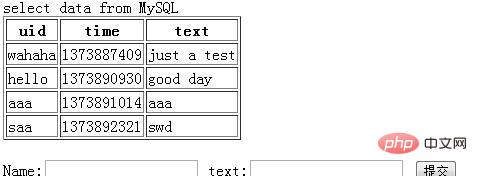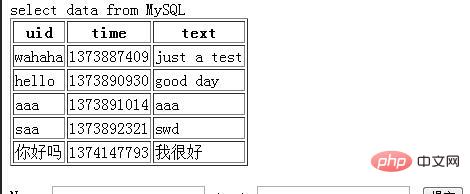How to install php and mysql in redhat
How to install php and mysql in redhat: 1. Install Apache2 through "yum install httpd" and start it; 2. Use "yum install mysql mysql-server" to install MySQL and start it; 3. Through "yum install php "Install PHP and then restart Apache to make php take effect.

The operating environment of this tutorial: Windows 10 system, PHP5 version, DELL G3 computer
How to install php and mysql in redhat?
Install and deploy Apache MySQL PHP environment on RedHat
1. Install Apache2
yum install httpd
After the Apache installation is completed, manually start Apache2
/etc/init.d/httpd start
At this time, enter the IP address of the server directly in the browser to see the default page of Apache2. At this time, Apache can only provide HTTP services, cannot execute PHP, and cannot connect to the MySQL database.
2. After installing MySQL
yum install mysql mysql-server
, use the following command to start the MySQL service:
/etc/init.d/mysqld start
3. Install PHP5
yum install php
After installing php5, Apache must be restarted to make php take effect:
/etc/init.d/httpd restart
At this time, Apache can parse and execute php scripts. Since the default website root directory of Apache is located at: /var/www/html/, create an info.php in this directory to test whether Apache PHP is correctly installed:
echo "<?php phpinfo(); ?>" > /var/www/html/info.php
Then visit it in the browser IP/info.php, if the output information of PHPINFO appears, the installation is successful
Install the mysql module of php
yum install php-mysql
After completion, restart Apache again
/etc/init.d/httpd restart
Finally, you need to The LAMP component is set to start automatically:
chkconfig --levels 2345 httpd on chkconfig --levels 2345 mysqld on
Test environment (virtual machine):
Log in to the local MySQL to create a table, create a user, and set the user's operation permissions on the table
use test;
create table login(
uid char(20),
dt int,
text char(50)
);
grant select,insert,update,delete on *.* to alan@"%" identified by 'password';
test.php
<?php
$host = 'xxx.xxx.xxx.xxx';
$user = 'alan';
$passwd = 'password';
$db = 'test';
$conn = mysql_connect($host,$user,$passwd);
if (!$conn) {
die('Could not connect: ' . mysql_error());
}
echo "select data from MySQL<br \>";
mysql_select_db($db, $conn);
$select_sql = "select * from login";
$result = mysql_query($select_sql);
echo "<table border='1'><tr><th>uid</th><th>time</th><th>text</th></tr>";
while ($row = mysql_fetch_array($result)) {
echo "<tr>";
echo "<td>".$row['uid']."</td>";
echo "<td>".$row['dt']."</td>";
echo "<td>".$row['text']."</td>";
echo "</tr>";
}
echo "</table><br \>";
echo "<form action='insert.php' method='post'>
Name:<input type='text' name='uid' />
text:<input type='text' name='text' />
<input type='submit'></form>";
mysql_close($conn);
?>
insert.php
<?php
$host = 'xxx.xxx.xxx.xxx';
$user = 'alan';
$passwd = 'password';
$db = 'test';
$conn = mysql_connect($host,$user,$passwd);
if (!$conn) {
die('Could not connect: ' . mysql_error());
}
mysql_select_db($db, $conn);
$dt = time();
$insert_sql = "insert into login(uid,dt,text) values('$_POST[uid]', $dt, '$_POST[text]')";
echo "SQL: ".$insert_sql."<br \>";
if (!mysql_query($insert_sql, $conn)) {
die('Error: ' . mysql_error());
}
echo "1 record added.<br \>";
mysql_close($conn);
?>1. Visit the page

2. Submit the form and execute a sql insert statement

3 . Return to the page and refresh to view the results

Related configuration and environment
Apache main configuration file:/etc/httpd/conf/httpd.conf
Apache main configuration directory, you can put different types of configurations into this directory: /etc/httpd/conf.d/
Apache website root directory: /var/www/html/
Apache log file directory:/var/log/httpd
MySQL my.cnf configuration file:/etc/my.cnf
MySQL database file location:/usr/lib/ mysql
Recommended learning: "PHP Video Tutorial"
The above is the detailed content of How to install php and mysql in redhat. For more information, please follow other related articles on the PHP Chinese website!

Hot AI Tools

Undresser.AI Undress
AI-powered app for creating realistic nude photos

AI Clothes Remover
Online AI tool for removing clothes from photos.

Undress AI Tool
Undress images for free

Clothoff.io
AI clothes remover

Video Face Swap
Swap faces in any video effortlessly with our completely free AI face swap tool!

Hot Article

Hot Tools

Notepad++7.3.1
Easy-to-use and free code editor

SublimeText3 Chinese version
Chinese version, very easy to use

Zend Studio 13.0.1
Powerful PHP integrated development environment

Dreamweaver CS6
Visual web development tools

SublimeText3 Mac version
God-level code editing software (SublimeText3)

Hot Topics
 1657
1657
 14
14
 1415
1415
 52
52
 1309
1309
 25
25
 1257
1257
 29
29
 1230
1230
 24
24
 Laravel Introduction Example
Apr 18, 2025 pm 12:45 PM
Laravel Introduction Example
Apr 18, 2025 pm 12:45 PM
Laravel is a PHP framework for easy building of web applications. It provides a range of powerful features including: Installation: Install the Laravel CLI globally with Composer and create applications in the project directory. Routing: Define the relationship between the URL and the handler in routes/web.php. View: Create a view in resources/views to render the application's interface. Database Integration: Provides out-of-the-box integration with databases such as MySQL and uses migration to create and modify tables. Model and Controller: The model represents the database entity and the controller processes HTTP requests.
 The Continued Use of PHP: Reasons for Its Endurance
Apr 19, 2025 am 12:23 AM
The Continued Use of PHP: Reasons for Its Endurance
Apr 19, 2025 am 12:23 AM
What’s still popular is the ease of use, flexibility and a strong ecosystem. 1) Ease of use and simple syntax make it the first choice for beginners. 2) Closely integrated with web development, excellent interaction with HTTP requests and database. 3) The huge ecosystem provides a wealth of tools and libraries. 4) Active community and open source nature adapts them to new needs and technology trends.
 MySQL and phpMyAdmin: Core Features and Functions
Apr 22, 2025 am 12:12 AM
MySQL and phpMyAdmin: Core Features and Functions
Apr 22, 2025 am 12:12 AM
MySQL and phpMyAdmin are powerful database management tools. 1) MySQL is used to create databases and tables, and to execute DML and SQL queries. 2) phpMyAdmin provides an intuitive interface for database management, table structure management, data operations and user permission management.
 Laravel framework installation method
Apr 18, 2025 pm 12:54 PM
Laravel framework installation method
Apr 18, 2025 pm 12:54 PM
Article summary: This article provides detailed step-by-step instructions to guide readers on how to easily install the Laravel framework. Laravel is a powerful PHP framework that speeds up the development process of web applications. This tutorial covers the installation process from system requirements to configuring databases and setting up routing. By following these steps, readers can quickly and efficiently lay a solid foundation for their Laravel project.
 MySQL vs. Other Programming Languages: A Comparison
Apr 19, 2025 am 12:22 AM
MySQL vs. Other Programming Languages: A Comparison
Apr 19, 2025 am 12:22 AM
Compared with other programming languages, MySQL is mainly used to store and manage data, while other languages such as Python, Java, and C are used for logical processing and application development. MySQL is known for its high performance, scalability and cross-platform support, suitable for data management needs, while other languages have advantages in their respective fields such as data analytics, enterprise applications, and system programming.
 The Compatibility of IIS and PHP: A Deep Dive
Apr 22, 2025 am 12:01 AM
The Compatibility of IIS and PHP: A Deep Dive
Apr 22, 2025 am 12:01 AM
IIS and PHP are compatible and are implemented through FastCGI. 1.IIS forwards the .php file request to the FastCGI module through the configuration file. 2. The FastCGI module starts the PHP process to process requests to improve performance and stability. 3. In actual applications, you need to pay attention to configuration details, error debugging and performance optimization.
 Explain the purpose of foreign keys in MySQL.
Apr 25, 2025 am 12:17 AM
Explain the purpose of foreign keys in MySQL.
Apr 25, 2025 am 12:17 AM
In MySQL, the function of foreign keys is to establish the relationship between tables and ensure the consistency and integrity of the data. Foreign keys maintain the effectiveness of data through reference integrity checks and cascading operations. Pay attention to performance optimization and avoid common errors when using them.
 How to safely store JavaScript objects containing functions and regular expressions to a database and restore?
Apr 19, 2025 pm 11:09 PM
How to safely store JavaScript objects containing functions and regular expressions to a database and restore?
Apr 19, 2025 pm 11:09 PM
Safely handle functions and regular expressions in JSON In front-end development, JavaScript is often required...




